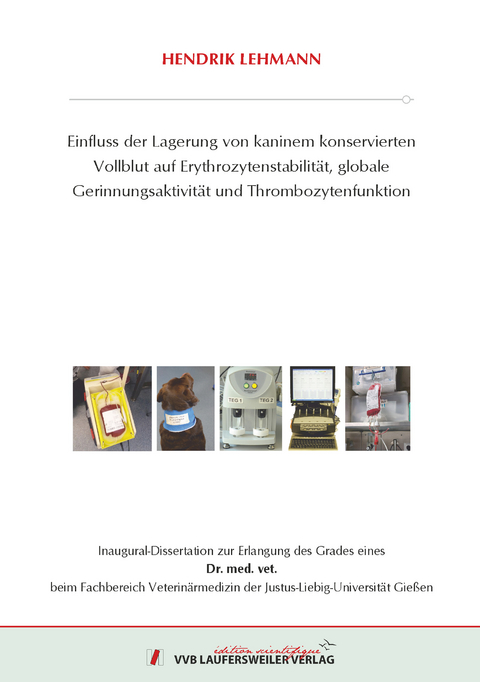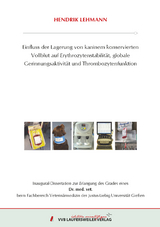Einfluss der Lagerung von kaninem konservierten Vollblut auf Erythrozytenstabilität, globale Gerinnungsaktivität und Thrombozytenfunktion
Seiten
2021
VVB Laufersweiler Verlag
978-3-8359-7010-6 (ISBN)
VVB Laufersweiler Verlag
978-3-8359-7010-6 (ISBN)
- Keine Verlagsinformationen verfügbar
- Artikel merken
Ziel der Arbeit war es, die Lagerung von Vollblut bei 4 °C im Verlauf von 28 Tagen Lagerung in Bezug auf Lagerungsschäden, globaler Hämostase und Thrombozyten-funktion zu untersuchen, um Empfehlungen für die Lagerung von Vollblut zur Therapie akuter Blutungen zu formulieren. Zu diesem Zweck wurde 21 ausgewachsenen, gesunden, regelmäßig geimpften und entwurmten Hunden mit einem ruhigen Gemüt und schwerer als 27 kg 450 ml Vollblut im Zeitraum vom 13. Januar 2021 bis 1. März 2021 im Zuge einer regulären Blutspende entnommen. Die Studie hat vom Regierungspräsidium folgendes Aktienzeichen erhalten: V 54 - 19 c 20 15 h 02 GI 18/17 kTV 16/2020. Um interindividuelle Unterschiede der Thrombozytenfunktion zu eliminieren, wurden je 220 ml Vollblut aus jedem gespendeten Vollblutbeutel entnommen und mit je 2 anderen, am selben Tag entnommenen Vollblutspenden gepoolt, sodass 7 Vollblutpools entstanden. Diesem Poolbeutel wurden zweimal 50 ml entnommen und in je einem leeren Blutbeutel aliquotiert. Der erste 50 ml Vollblutbeutel wurde der Gruppe VB zugeordnet, dem zweiten Vollblutbeutel wurden 11 ml einer Erythro-zytennährlösung zugesetzt und er wurde anschließend der Gruppe VBPAGGS zuge-ordnet. Die Blutprodukte wurden aufrecht bei 4 °C gelagert und jeden zweiten Tag geschwenkt, um die Zellen und Nährmedien gleichmäßig zu durchmischen. Am Tag der Blutspende (Tag 0) sowie an den Tagen 1, 3, 5, 10, 15, 21 und 28 nach Blutent-nahme wurden ausführliche labordiagnostische Untersuchungen zur Evaluierung der Lagerungsschäden, globalen Hämostase und Thrombozytenfunktion durchgeführt. Dies beinhaltete die serielle Untersuchung der Glukose-, Laktat-, Kalium-, Phosphat-, Ammoniak- und LDH-Konzentration sowie die Entwicklung des pH-Wertes. Zelluläre Parameter zur Beurteilung der Hämolyse, sowie der Veränderungen der Thrombozytenmorphologie und Struktur mittels der Thrombozytenindices wie der MPC und PCDW wurden durch das auf Durchflusszytometrie basierte Hämatologiesystem ADVIA 2120i (Siemens Healthcare) ermittelt. Die globale Hämostase wurde durch Thrombelastographie untersucht. Die Thrombozytenfunktion wurde mittels Impedanzaggregometrie nach ADP- und Kollagenaktivierung erfasst. Eine Sterilitätskontrolle erfolgte an den Tagen 0, 3, 5, 15 und 28.
Die Lagerung hatte erwartungsgemäß einen signifikanten Einfluss auf die Entwicklung der Metabolite. Die Glukosekonzentration sank ab Tag 3 der Lagerung signifikant ab (p = 0,011), während die Laktatwerte in beiden Gruppen ab Tag 1 signifikant anstiegen (p < 0,001). Die Hämolyse in beiden Gruppen stieg während der 28 Tage Lagerung an, lag aber deutlich unter dem vorgegebenen Maximalwert von 0,8 %. Die Parameter der globalen Hämostase waren während der ersten 15 Tage der kühlen Lagerung stabil und blieben innerhalb des Referenzintervalles. Ab Tag 21 war ein deutlicher Abfall der globalen Gerinnungsaktivität nachweisbar. Die Thrombozytenfunktion der kalt gelagerten Thrombozyten in beiden Vollblutgruppen fiel im Verlauf der Lagerung ab dem dritten Tag signifikant ab (p = 0,002) und erreichte noch ungefähr ein Drittel der ursprünglichen Funktion an Tag 15. In Kombination mit den Ergebnissen der zellulären Veränderungen und der globalen Hämostase lassen die Ergebnisse die Schlussfolgerung zu, dass Vollblut für 15 Tage bei 4 °C gelagert werden kann und dabei ausreichend hämostatische Kapazität und Thrombozytenfunktion behält.
Dabei hat die Verwendung einer zusätzlichen Erythrozytennährlösung während der Lagerung der Erythrozyten und Thrombozyten bzw. Thrombozytenfunktion und globalen Hämostase keinen Vorteil gezeigt. The aim of this study was the evaluation of the storage of whole blood at 4 °C over 28 days regarding storage lesion parameter, global hemostasis and platelet function so that recommendations for the storage of whole blood for the treatment of acute hemorrhage can be made. For this purpose, 21 healthy, adult, client-owned and calm dogs, that are regularly vaccinated and dewormed were recruited. They had to be heavier than 27 kg and donated in average 450 ml whole blood on a regular basis. The donations were performed between 13th of January and 1st of March 2021. The study was approved by the regional council of Gießen and is registered under following reference number: V 54 - 19 c 20 15 h 02 GI 18/17 kTV 16/2020. To avoid inter-individual differences in platelet function, 220 ml of each donated whole blood bag was seperated and pooled with 220 ml of 2 other blood bags donated at the same day resulting in 7 whole blood pools. Out of these pooled blood bags, 100 ml were evacuated and aliquoted in 2 separate empty blood bags. The first aliquoted 50 ml blood bag was assigned to the group whole blood (VB), whereas the second 50 ml whole blood bag was assigned to group VBPAGGS after instilling 11 ml of an erythrocyte nutrition solution. All blood bags were stored in an upright position in a commercial refrigerator for blood bags and were gently mixed every other day to assure an adequate mixture of cells and nutritional solution. At the day of donation (day 0) and on the days 1, 3, 5, 10, 15, 21 and 28 after donation, an extensive laboratory evaluation was performed regarding the impact of storage lesion, global hemostasis and platelet function. Measurements included serial assessment of concentrations of glucose, lactate, potassium, phosphate and ammonia and LDH-activity as well as pH of the stored whole blood. Cellular parameters to evaluate hemolysis as well as changes of the platelet morphology and structure were assessed by measuring platelet indices like MPC and PCDW using the flowcytometry-based hematology analyzer ADVIA 2120i (Siemens Healthcare). Global hemostasis was evaluated using thrombelastography. Platelet function was assessed using impedance-based aggregometry utilising ADP and Collagen for platelet activation. For assessment of sterility, bacterial cultures of both groups were submitted at days 0, 3, 5, 15 and 28.
As expected, storage had a significant impact on metabolites. In both groups, the glucose concentration decreased significantly at day 3 (p = 0,011), whereas the lactate concentration increased already after 1 day of storage (< 0,001). The grade of hemolysis increased also in both groups within 28 days, but remained below the recommended threshold of 0,8 %. Parameters reflecting global hemostasis were stable within the first 15 days of cold storage and remained within the reference interval. After day 21, a significant decline of hemostatic activity was noted. The platelet function of the cold stored whole blood products decreased significantly beginning on day 3 of storage (p = 0,002) and decreased further reaching one third of the initial function at day 15. Under consideration of the results of cellular changes, global hemostasis and platelet function over the period of 28 days storage at 4 °C, it could be concluded, that storage of whole blood at 4 °C is possible for 15 days, whereby still sufficient hemostatic capacity and platelet function remained. The addition of the erythrocyte nutrition solution did not show any benefit.
Die Lagerung hatte erwartungsgemäß einen signifikanten Einfluss auf die Entwicklung der Metabolite. Die Glukosekonzentration sank ab Tag 3 der Lagerung signifikant ab (p = 0,011), während die Laktatwerte in beiden Gruppen ab Tag 1 signifikant anstiegen (p < 0,001). Die Hämolyse in beiden Gruppen stieg während der 28 Tage Lagerung an, lag aber deutlich unter dem vorgegebenen Maximalwert von 0,8 %. Die Parameter der globalen Hämostase waren während der ersten 15 Tage der kühlen Lagerung stabil und blieben innerhalb des Referenzintervalles. Ab Tag 21 war ein deutlicher Abfall der globalen Gerinnungsaktivität nachweisbar. Die Thrombozytenfunktion der kalt gelagerten Thrombozyten in beiden Vollblutgruppen fiel im Verlauf der Lagerung ab dem dritten Tag signifikant ab (p = 0,002) und erreichte noch ungefähr ein Drittel der ursprünglichen Funktion an Tag 15. In Kombination mit den Ergebnissen der zellulären Veränderungen und der globalen Hämostase lassen die Ergebnisse die Schlussfolgerung zu, dass Vollblut für 15 Tage bei 4 °C gelagert werden kann und dabei ausreichend hämostatische Kapazität und Thrombozytenfunktion behält.
Dabei hat die Verwendung einer zusätzlichen Erythrozytennährlösung während der Lagerung der Erythrozyten und Thrombozyten bzw. Thrombozytenfunktion und globalen Hämostase keinen Vorteil gezeigt. The aim of this study was the evaluation of the storage of whole blood at 4 °C over 28 days regarding storage lesion parameter, global hemostasis and platelet function so that recommendations for the storage of whole blood for the treatment of acute hemorrhage can be made. For this purpose, 21 healthy, adult, client-owned and calm dogs, that are regularly vaccinated and dewormed were recruited. They had to be heavier than 27 kg and donated in average 450 ml whole blood on a regular basis. The donations were performed between 13th of January and 1st of March 2021. The study was approved by the regional council of Gießen and is registered under following reference number: V 54 - 19 c 20 15 h 02 GI 18/17 kTV 16/2020. To avoid inter-individual differences in platelet function, 220 ml of each donated whole blood bag was seperated and pooled with 220 ml of 2 other blood bags donated at the same day resulting in 7 whole blood pools. Out of these pooled blood bags, 100 ml were evacuated and aliquoted in 2 separate empty blood bags. The first aliquoted 50 ml blood bag was assigned to the group whole blood (VB), whereas the second 50 ml whole blood bag was assigned to group VBPAGGS after instilling 11 ml of an erythrocyte nutrition solution. All blood bags were stored in an upright position in a commercial refrigerator for blood bags and were gently mixed every other day to assure an adequate mixture of cells and nutritional solution. At the day of donation (day 0) and on the days 1, 3, 5, 10, 15, 21 and 28 after donation, an extensive laboratory evaluation was performed regarding the impact of storage lesion, global hemostasis and platelet function. Measurements included serial assessment of concentrations of glucose, lactate, potassium, phosphate and ammonia and LDH-activity as well as pH of the stored whole blood. Cellular parameters to evaluate hemolysis as well as changes of the platelet morphology and structure were assessed by measuring platelet indices like MPC and PCDW using the flowcytometry-based hematology analyzer ADVIA 2120i (Siemens Healthcare). Global hemostasis was evaluated using thrombelastography. Platelet function was assessed using impedance-based aggregometry utilising ADP and Collagen for platelet activation. For assessment of sterility, bacterial cultures of both groups were submitted at days 0, 3, 5, 15 and 28.
As expected, storage had a significant impact on metabolites. In both groups, the glucose concentration decreased significantly at day 3 (p = 0,011), whereas the lactate concentration increased already after 1 day of storage (< 0,001). The grade of hemolysis increased also in both groups within 28 days, but remained below the recommended threshold of 0,8 %. Parameters reflecting global hemostasis were stable within the first 15 days of cold storage and remained within the reference interval. After day 21, a significant decline of hemostatic activity was noted. The platelet function of the cold stored whole blood products decreased significantly beginning on day 3 of storage (p = 0,002) and decreased further reaching one third of the initial function at day 15. Under consideration of the results of cellular changes, global hemostasis and platelet function over the period of 28 days storage at 4 °C, it could be concluded, that storage of whole blood at 4 °C is possible for 15 days, whereby still sufficient hemostatic capacity and platelet function remained. The addition of the erythrocyte nutrition solution did not show any benefit.
| Erscheinungsdatum | 22.01.2022 |
|---|---|
| Reihe/Serie | Edition Scientifique |
| Verlagsort | Gießen |
| Sprache | deutsch |
| Maße | 148 x 210 mm |
| Gewicht | 220 g |
| Themenwelt | Veterinärmedizin ► Allgemein |
| Schlagworte | Blutkonserven • Hund • Transfusion |
| ISBN-10 | 3-8359-7010-0 / 3835970100 |
| ISBN-13 | 978-3-8359-7010-6 / 9783835970106 |
| Zustand | Neuware |
| Informationen gemäß Produktsicherheitsverordnung (GPSR) | |
| Haben Sie eine Frage zum Produkt? |
Mehr entdecken
aus dem Bereich
aus dem Bereich
Buch | Softcover (2025)
Mensch & Buch (Verlag)
CHF 69,85


